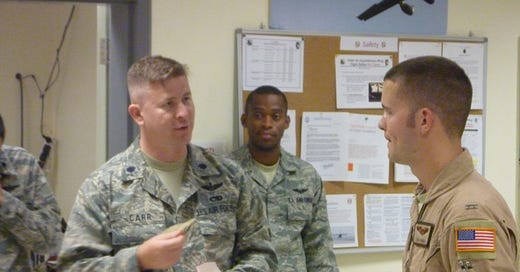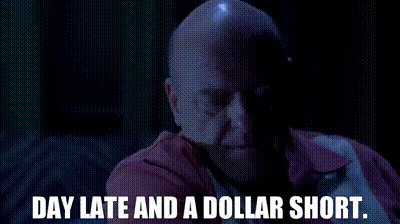It is a well known fact among American aircrews that the first order of business after arriving in a deployed location is to establish perfect situational awareness of the precise number of seconds remaining before you can go home.
Sure, thinking about each tick of the clock makes the passage of time excruciatingly gradual. But reveling in self-torment is a long-held default of military life.
In my day, we had the “Donut of Misery.” An excel-based countdown clock which turned a circle less red and more green with each incessant stroke of F5.
Every refresh brought a tiny but tangible reduction in seconds remaining. Such precise agony, delivered with such agonizing precision, was like on-demand meth hits for aircrews who measure everything one degree at a time.
The big payoff was seeing the donut turn completely green. This meant it was time to levitate with glee. The only thing better than seeing the fully green donut was never seeing it because you somehow went home early.
But no one goes home early. Attempting the early go-home is the bureaucratic equivalent of breaking open a parking meter to steal quarters. Maddening, exhausting, and the time invested ends up outweighing the meager payoff.
But also, no one stays over. Because as slow as time goes when the donut is counting down, overtime passes at an insufferable, eternal, third-level-of-inception pace. Deployed overtime is pestilence in temporal form.
Thus, if I were to venture a morsel of folksy wisdom for passage down the ages, it would be this: woe betide anyone who, by act or omission, gets between a green donut and an airman’s ride home.
I know what that’s about. Because I did it. And somehow lived to tell about it.
About four months into my command of a C-17 squadron deployment in 2011, it occurred to me that we were only a month from going home, yet I had not heard anything about arrangements to get us there.
Digging feverishly through my overstuffed inbox, I found a 10-day-old message from a nondescript 5-digit sub-office in a cubicle farm 7,000 miles away.
The message had been snared by one of my shit filters and flung into a sub-folder, one of many message prisons where I sent useless missives to die.
Reviewing the needlessly dense contents, I recognized two things were true.
First, there were some bureaucratic validation steps required before I could be confident in my team’s ride home.
Second, those steps had been due a few days earlier. I was late.
And when you are late in a bureaucracy, you are at the mercy of a waiver. And such waivers, and the power to deny them, comprise the totality of power wielded by hapless bureaucrats envious of those with better lots in life.
As a pilot, I was hated by bureaucrats for daring to exist. Giving them a chance to make me bleed was the last place I wanted to be.
Because bureaucrats are petty and ignoble creatures, waivers are often denied purely for the gratification of the denier. In cases where they are granted, a lot of undignified begging and ring-kissing are required.
And yet, I was optimistic, because I had good leaders who would advocate on my behalf and we were still early enough in the process for common sense to prevail.
This was naive.
I’d over-estimated both the authority of my leaders and the capacity for common sense of anyone involved.
Our waiver request was denied, re-denied, and further attempts at re-submission ignored. I was ghosted. When I tried making an insubordinate pest of myself to re-establish contact, I was given a direct order to drop the issue.
And so it transpired that 200 airmen would go home days late because of my error. And if you retain any doubt about the level of misery this inflicted, I refer you to the aforementioned donut of misery and how it operates.
Employing a range of black market and gray market techniques, we managed to spirit home those who really needed to get there on time.
But those who remained behind went home with two additional possessions. First, great suntans from days spent sitting motionless by the pool waiting for time to pass. And second, a newfound disappointment in their leader and the Air Force he represented.
I will add here that in my recounting of this debacle, I’ve somewhat falsely painted myself as more villain than accomplice, even though my sin was failing to fully comprehend the incomprehensible decrepitude of a process so shittily designed that even my jaded, cynical brain underestimated its absurdity. A decade-plus later, I’m still mystified.
But none of that mattered. As a commander, it was my job to be wily enough to anticipate and outmaneuver any and all clowns attempting to flop their shoes in my organization.
I had failed to do so because I had failed to maintain a sufficient level of administrative awareness to effectively discharge my role.
In the year I had commanded the Pelicans, we had achieved beyond anyone’s expectations.
We’d built ourselves into one of the best trained and capable C-17 squadrons in the US Air Force. We’d broken the record for mass airdropped by a single unit in a single deployment, supporting a vast reduction in ground convoys.
Everyone had put their heart and soul into preparing for and executing an epic deployment, and the awards, promotions, and opportunities which followed were a reflection of that.
The source of that greatness … had been flying and fighting with heart.
We had shared values, a common purpose, and a sense of belonging.
Everyone signed onto my vision for the unit and it helped us unify into an incredibly coherent, positive, smiling team.
My airmen poured oceans of discretionary effort into that year, nailing their combat test with flying colors.
And then, I unwittingly conspired with an insane clown posse to rob them of the one reward they cared most about: going home.
I let them down, and it hit as hard as it should.
Here’s what I learned: love ain’t enough.
Leading with heart is fun. It’s fulfilling.
But without a brain and bones, an inspired organization is nothing more than a throbbing lump of love forlorn.
In the course of the decade since, navigating analogous situations many times, I have developed a more complete theory about what leadership really is, because it’s about much more than loving your team and getting them to love each other.
The age-old debate about leaders vs. managers is the wrong framing, and it’s incomplete.
Everyone in a position giving them responsibility over others in an organization is a leader.
And also a manager.
And also an administrator.
Any leader, every leader, is doing three jobs all the time. Each of these jobs comes with imperatives reflecting the organization’s objectives, strategy, constraints, and systems.
If that sounds complicated, good. Because we’ve been over-simplifying what it means to lead for too long already.
Leadership is juggling. Re-balancing. Dynamically re-prioritizing. It’s respecting the constantly shifting imperatives of leadership, management, and administration.
At a given moment, one of these will need more from you. And in the next moment, another. And this means you’re shifting gears all the time. And that chaos is unavoidable and OK.
The only thing that isn’t OK is to overly neglect any of these three imperatives for too long.
On the deployment, I had chopped the size of my front office. I had reduced the time I was spending on my own inbox, choosing to focus instead on execution, tactical innovation, and the recognition and development of my team.
But if I am honest with myself, it was as much about how I preferred to spend my time as it was the actual demands placed upon it.
A clearer and more intentional thought process would have nudged me into less pernicious neglect of administration, and this would have made a huge difference in outcomes for my team, their morale, and my effectiveness.
Each of us has a preferred mode. I liked leading with heart. Others enjoy managerial functions. Still others enjoy rules, order, and clarity.
But without all three modes getting respected, something will get missed. An opportunity will fly by or a threat will fly too close.
Each of us needs to find in our role what motivates us. What serves as a source of energy for us as the excitement of promotion wears off and the long march of responsibility sets in.
It’s perfectly fine to accentuate what you prefer.
But stay intentional. Stay rounded.
And in your paranoid “what am I missing” moments, shine a light into the corner of where you’re least comfortable. I hated administration then, and still hate it now. But I learned to respect it after it bit me on the ass.
This has been a story of one of the many times I’ve screwed up and what I learned.
I will close with a piece of advice for executives and high-level leaders, current and future.
If people don’t seem to want leadership roles in your organization, seek to understand the particular requirements of those roles and how the balance between leadership, management, and administration might be turning people off.
The Air Force, for all its combat prowess, failed for many years to prevent clowns breeding and multiplying so fast that administration became the dominant feature of command. Lots of great people took a look at that and declined.
When you’ve been conditioned for a dozen years to equate command with leadership and come to realize it is mainly rule re-transmission with some token management obligations, the excitement bleeds off quickly. Ever try giving your cat discount meat instead of the fancy feast they’ve been promised? Same thing.
Amazon operations was all about strong management. For a few years, it tried to grow heart into its management roles, and this helped it triple operational size in a few short years. Trust, after all, is faster than process or structure.
But as often happens when businesses become cost-conscious, Amazon shifted violently into administration the last couple years and became about as enjoyable as a dentist’s chair for me and others built like me.
I don’t think most of us are intentional about understanding the requirements of what we do in leadership roles.
And I don’t think most organizations are clear about what their leadership roles actually expect for people to be effective in them.
The good news is that clarity is available and reachable with just a bit more conscious effort.
That’s all for today … for some reason I am craving a donut.
TC is an independent writer, speaker, coach, and consultant specializing in organizational leadership.













I really enjoyed this piece. Thanks for sharing.